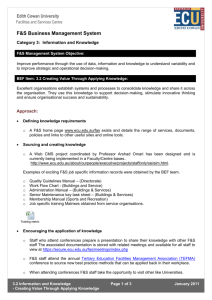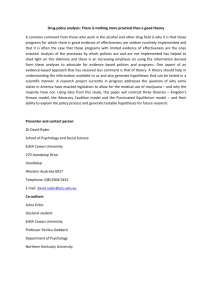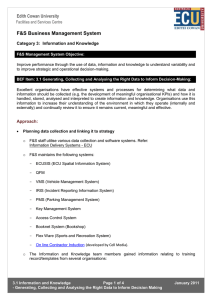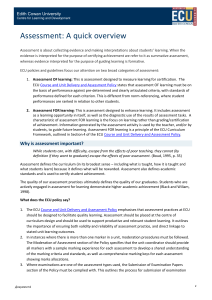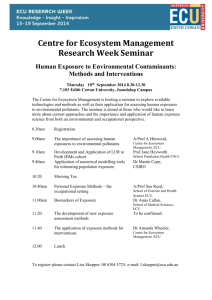Electrical Workers of ECU
advertisement
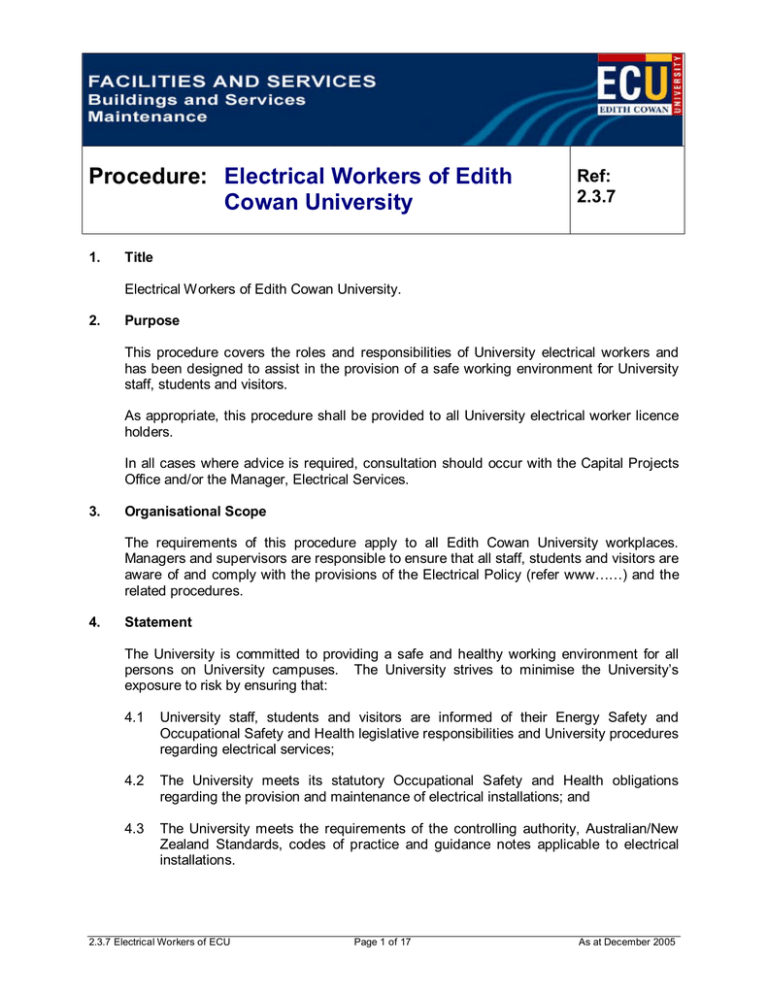
Procedure: Electrical Workers of Edith Cowan University 1. Ref: 2.3.7 Title Electrical Workers of Edith Cowan University. 2. Purpose This procedure covers the roles and responsibilities of University electrical workers and has been designed to assist in the provision of a safe working environment for University staff, students and visitors. As appropriate, this procedure shall be provided to all University electrical worker licence holders. In all cases where advice is required, consultation should occur with the Capital Projects Office and/or the Manager, Electrical Services. 3. Organisational Scope The requirements of this procedure apply to all Edith Cowan University workplaces. Managers and supervisors are responsible to ensure that all staff, students and visitors are aware of and comply with the provisions of the Electrical Policy (refer www……) and the related procedures. 4. Statement The University is committed to providing a safe and healthy working environment for all persons on University campuses. The University strives to minimise the University’s exposure to risk by ensuring that: 4.1 University staff, students and visitors are informed of their Energy Safety and Occupational Safety and Health legislative responsibilities and University procedures regarding electrical services; 4.2 The University meets its statutory Occupational Safety and Health obligations regarding the provision and maintenance of electrical installations; and 4.3 The University meets the requirements of the controlling authority, Australian/New Zealand Standards, codes of practice and guidance notes applicable to electrical installations. 2.3.7 Electrical Workers of ECU Page 1 of 17 As at December 2005 5. Definitions Authorised Person – A person having permission from the University, or the appropriate authority, to undertake electrical work. Australian Standard – The Australian standard published by the Standards Association of Australia. Building Code – The current Building Code of Australia including amendments. Clear Access – Unimpeded access to designated area, with a minimum clearance of 900mm greater than the radius of any opening door. Campus Manager – The person occupying the position of Facilities Manager at each of the campuses. Campus Electrician – The licensed electrician nominated as the campus electrician at each campus. Certificate of Competency – A certificate certifying that a person has acquired the knowledge and skills to enable them to perform the task required, in a safe and effective manner. Code of Practice – A code of practice approved by the Minister under Part VIII of the Occupational Safety and Health Act 1984. Electrical Accident – An accident that has caused, or is likely to cause danger to life or property. The Electricity (Licensing) Regulations 1991 definition of an accident is: “An accident that results from a sudden discharge of electricity or that otherwise has, or may have, electrical origins.” Electrical Equipment/Appliance – An electricity consuming device or apparatus (including the cable) that is connected to or capable of being connected to the electrical installation. Electrical appliances can be classified into one of the following categories: • Portable electrical equipment – equipment that is connected to an electrical supply and intended to be moved when in use e.g. electric arc welder, electric high pressure water cleaner; • Hand-held – portable equipment that is intended to be held in the hand during normal use and the electrical motor forms an integral part of the equipment e.g. electric drill, angle grinder (excludes battery operated equipment); • Movable – an appliance that can be moved readily from one place to another by unplugging from a general purpose outlet, but that is not moved during operation e.g. cathode ray oscilloscope, electronic balance, personal computer, printer, etc. • Fixed/stationary – an appliance which is, in normal use, fastened to a support of otherwise secured in a specific position or is of such size or function as to be difficult or unlikely to be moved from one place to another, e.g. large workshop machinery (lathe, band saw, etc.), oven, refrigerator. Electrical Installation – All wiring, wiring enclosures switchgear, control and protective gear appliances and any other component permanently connected to or associated with the wiring that is on premises to which electricity is or intended to be supplied through distribution network. Electrical Licence – A licence issued under part 3 of the Electricity (Licensing) Regulations 1991. 2.3.7 Electrical Workers of ECU Page 2 of 17 As at December 2005 Electric Portable Device Outlet – A device, other than a cord extension set, having a single plug intended for connection to a mains outlet socket, a (EPDO) sheathed flexible cord and an assembly of one or more outlet (Power Board) sockets. It may incorporate a reeling or coiling arrangement. Electrical Workers – Licensed electrical workers who are employees of the University and are registered with the Manager, Electrical Services. Employer – Edith Cowan University. Electrical Supply – Voltages exceeding 50 Volts AC or 120Volts DC (Ripple Free). Hazard – Anything that may result in injury to the person; or harm to the health of a person. Isolation –Disconnected from all sources of supply by the operation of isolators, isolating links or fuses or connectors the physical break must be of a length appropriate to the voltage and insulation medium. Isolator – A device that, for reasons of safety, provides a physical break in the circuit in the open position. The length of the break is dependent on the voltage and the insulating medium. Live (Energised) - A term applied to all or part of electrical equipment when a difference of potential exists between it and the mass of earth under normal conditions of operation. Maintenance Officer – The person occupying the position of Site Maintenance Foreperson. Manager, Electrical Services – The person occupying the position of Manager, Electrical Services, Facilities and Services Centre. Manager Occupation Safety & Health – The person occupying the position of Manager, Occupational Safety and Health. Network Operator – The authority providing the transmission network for the distribution of electrical power. Plant – Any machinery, equipment, appliance, implement, or tool and any component or fitting thereof, or accessory thereto used in the execution of the work under the contract but not forming part of the works. Residual Current Device (RCD) – A mechanical switching device designed to make, carry and break currents under normal service conditions and to cause the opening of the contacts when the residual current attains a given value under specific conditions. Restricted Electrical Worker’s Licence – A licence issued under part 3 of the Electricity (Licensing) Regulations 1991 inclusive of restrictions placed on its use under the Act. Safety Observer – A person specifically assigned the duty of observing and warning against unsafe approach to equipment and other potential hazards. This is particularly important when working near live, exposed high voltage equipment. A safety observer shall be appropriately trained to initiate any emergency procedures associated with the task. 2.3.7 Electrical Workers of ECU Page 3 of 17 As at December 2005 Supply Authority – The authority supplying electricity in the area within which the electrical installation is situated and to the distribution network to which the electrical installation is connected. University Hazard Reporting Procedure – The reporting guidelines as set out at: http://www.ecu.edu.au/msc/hrs/osh/procedures/hazard/docs/Hazard_Resolution04.pdf University Premises – The place, whether in a building or grounds, owned, occupied, or controlled by the University. Voltages – constitutes the following: • Extra Low Voltage means a Voltage NOT exceeding 50 volts AC or 120 volts DC (Ripple Free); • Low Voltage means a voltage exceeding 50 volts AC or 120 volts DC (Ripple Free) but NOT exceeding 1000 volts AC or 1500 volts DC; • High Voltage means a voltage exceeding 1000 volts AC or 1500 volts DC. 6. Principles The University has statutory obligations to implement safe systems of work to prevent persons from being exposed to electrical hazards. University employees, students and visitors are required to read and comply with the requirements of this procedure. It is strictly prohibited for unlicensed persons to undertake any repairs or modifications to University electrical equipment or wiring. Only persons registered with the Manager, Electrical Services are permitted to carry out electrical work. Work on University electrical installations is not permitted without the appropriate authorisation as dictated by this procedure. All electrical equipment and appliances used on University premises shall comply with the requirements of the University procedures. Any project involving electrical additions, alterations or maintenance of University electrical installations, shall be authorised and project managed by the University’s Facilities and Services Centre. If in doubt about any part of this procedure, or general responsibility associated with electrical safety, contact should be made with the Manager, Electrical Services Facilities and Services Centre , or the Manager, Occupational Safety and Health. 7. Content 7.1 Management Responsibilities a) Nominee To be eligible as a nominated Electrical Worker, the Edith Cowan University employee must meet the requirements of the Electricity (Licensing) Regulations 1991 Regulation 36(1)(a) and (b). The nominated Electrical Worker should have authority and responsibility for the following, as per the Electrical Workers of ECU procedure available from http://www.ecu.edu.au/fas/procedures/search.php 2.3.7 Electrical Workers of ECU Page 4 of 17 As at December 2005 • • • • • • b) Completion and submission of notices; Electrical log book entries; Recording of electrical workers; Reporting of electric shocks and electrical accidents; Isolation and testing procedures; Supervision. Record of Electrical Workers To meet the requirements of the Electricity (Licensing) Regulations 1991 Regulation 57, Edith Cowan University shall maintain and keep at its principle place of business a record of the holder of the licence and shall keep this record for a period of 2 years after the holder of the licence has ceased to be employed or engaged by Edith Cowan University. The record shall include: • • • The name and residential address of the nominated Electrical Worker; The number, type and expiry date of the licence registration held by that person; and The particulars of the period during which the person has been employed. Licence details should be verified against the Energy Safety (formerly the Office of Energy) database by calling Energy Safety on (08) 9422 5252. The record of Electrical Workers must be available for viewing, on request, by the Electrical Licensing Board, a member of the Board or an Electrical Inspector. 7.2 Standards of work All electrical work shall be carried out in accordance with the requirements of the Electricity (Licensing) Regulations 1991 Regulation 49(1). Electrical Workers shall carry out electrical work in accordance with the requirements of: • The Australian and New Zealand Wiring Rules including amendments; and • The WA Electrical Requirements including amendments. Electrical work should also be carried out in accordance with the requirements of the following standards, as published by the Standards Association of Australia including amendments, where those standards are relevant to the type of electrical work being carried out, namely: • AS 2067 – Switchgear assemblies and ancillary equipment for AC Voltages above 1Kv; • AS 2381 – Electrical equipment for explosive atmospheres, selection installation and maintenance; • AS2430 – Classification of hazardous areas; • AS 3001 (sections 1 and 2 only) – Electrical installations, movable premises (including caravans) and their site installations; • AS3002 – Electrical installations, shows and carnivals; 2.3.7 Electrical Workers of ECU Page 5 of 17 As at December 2005 • AS3004 (sections 1 and 2 only) – Electrical installations, marinas and pleasure craft at low voltage; • AS3005 (sections 1 and 2 only) – Electrical installations of tents and similar temporary structures for domestic purposes; • AS3008 – Electrical installations, selection of cables; and • AS3010 – Electrical installations, supply by generating set. Where any Code or Standard is inconsistent with the WA Electrical Requirements, the latter prevails to the extent of the inconsistency. As a minimum, all electrical work will be carried out to appropriate Australian Standards. Holders of a restricted electrical worker’s licence must not carry out electrical installing work, alterations to fixed wiring, or repair/replace such items as socket outlets, light fittings etc. 7.3 Electrical log book An exemption, in writing, has been granted by the Director of Energy Safety (or delegate), Energy Safety, from the requirement to submit a minor works notice for electrical installing work performed by Electrical Workers at Churchlands, Mount Lawley and Joondalup campuses. Electrical log books are provided by the maintenance office at each campus to record details of all the electrical work carried out and should: • Be used solely for the recording of information specified in sections 1 and 2 of the log book and is not to be used for any other purpose; • Be kept in good condition and safely retained for the life of the installation; and • Have all entries recorded in ink. Electrical log books only of the form approved by the Director of Energy Safety, may be used for the recording of electrical installing work in lieu of notices and should be made available to the Electrical Inspector on request. The electrical log book is divided into two sections: a) Section 1 - record of electrical installing work All electrical installing work must be recorded in this section to comply with Electricity (Licensing) Regulations 1991 Regulations 51, 52 and 53. Each entry relating to electrical installing work must contain: • • • • b) The date the work was completed; A description of the work; The name and licence number of the electrical worker/s who carried out the work; A certification from the nominated Electrical Worker that the electrical installing work has been checked and tested and the work meets the requirements of the Electricity (Licensing) Regulations 1991. Section 2 - record of other electrical work/incidents This section is for the recording of other relevant information. The recording of this information is not mandatory. 2.3.7 Electrical Workers of ECU Page 6 of 17 As at December 2005 Entries relating to electrical work/incidents, as listed below, should include the following information: Electrical accidents/shocks: • Name and occupation of the person(s) involved; • Date of accident; • Where the accident occurred; • Name of person who made the entry; and • Date the entry was made. Fire suspected to be caused by electricity: • Date of incident; • Location of fire; • Origin of fire; • Brief description of the cause of the fire; • Name of person who made the entry; and • Date the entry was made. Dangerous occurrences involving electricity which could have caused injury to a person: • Date of occurrence; • Brief description of the incident; • Name of person who made the entry; and • Date the entry was made. Maintenance of electrical equipment: • Details of examinations and tests carried out; • Date work carried out; • Details of the person who carried out the work; and • Date the entry was made. 7.4 Completion and submission of notices To meet the requirements of the Electricity (Licensing) Regulations 1991 Regulations 51, 52 and 54, Edith Cowan University will ensure “A Notice of Completion” is correctly compiled and completed for campuses under the In House Electrical Licence. a) Compilation of a “Preliminary Notice” or “Notice of Completion” These notices shall be used to notify the relevant Network Operator of all electrical installing work such as installation of, or alterations to, the service equipment, main switchboard, the consumer mains, the main earthing conductors or involves the installation of private generating plant or additions and alterations to an existing installation operating at a pressure in excess of 650 Volts. • Preliminary Notice - The original copy shall be forwarded to the relevant Network Operator, so that it is received at least 3 (three) working days prior to the commencement of electrical installing work. If a Network Operator ruling is requested, the work should not commence until a written ruling from the Network Operator is received. 2.3.7 Electrical Workers of ECU Page 7 of 17 As at December 2005 • Notice of Completion - The original copy shall be forwarded to the relevant Network Operator, so that it is received within 3 (three) working days, after completion of the electrical installing work. Once the electrical installation has been completed satisfactorily, the Electrical Worker must check and test the electrical installing work (refer section 7.7(h)), verify that the installation is safe to connect to the electricity supply and should complete the appropriate sections of the notice and enter his electrical worker’s licence number and signature. Installing work or defects, which are not the responsibility of Electrical Workers, should be recorded on the notice. Notices that are not legible or duly completed in full, or for work which has not been completed, must not be submitted to the Network Operator. b) Certification for a “Notice of Completion” • The signature and printed surname must be that of the licensed nominated Electrical Worker. • The In-House licence number shown must be that of Edith Cowan University, not the electrical worker’s licence number. The letters IH must precede the licence number 7.5 Occupational Safety and Health Regulations 1996 Requirements for Workplace Electrical installations To meet the requirements of the Occupational Safety and Health Regulations 1996 Regulation 3.59, Edith Cowan University shall ensure that all electrical installations at their workplace shall be designed, constructed, installed, maintained and tested so as to minimise the risk of electric shock or fire. Edith Cowan University shall ensure that each connection on a flexible cord is either a moulded one part non-rewirable or transparent type plug top. a) Protection against earth leakage current To meet the requirements of the Occupational Safety and Health Regulations 1996 Regulation 3.60 in a workplace other than to which AS/NZS3012 “Electrical Installations-Construction and Demolition Sites” applies or to a workplace at which the supply of electricity: • does not exceed 32 volts alternating current; • is direct current; • is provided through an isolating transformer complying with AS/NZS 3108; or • is provided from the unearthed outlet of a portable generator. Edith Cowan University shall: • ensure that all non portable Residual Current Devices (RCD's) installed at the workplace are kept in a safe working condition and are tested on a regular basis (in accordance with AS/NZS 3760) to ensure its continued effective operation; • provide, where electricity is supplied to portable equipment through a fixed socket at the workplace, protection against earth leakage current by means of: 2.3.7 Electrical Workers of ECU Page 8 of 17 As at December 2005 - a non portable RCD installed at the switchboard; - a non portable RCD built into a fixed socket outlet which, having regard to the primary use of the socket outlet and its location, is likely to be used by a person operating portable equipment; and • ensure that where a non portable RCD has: - been installed at a switchboard, that a notice is displayed in a prominent place at or near the switchboard indicating that a non portable RCD has been installed at the switchboard; or - been built into a fixed socket outlet, that the socket outlet can be identified as providing protection against earth leakage current; - all RCD protected socket outlets, that these are to be appropriately labelled at the socket outlet. - all non-RCD protected socket outlets, that these are to be appropriately labelled at the socket outlet. - socket outlets that do not bear a label, that these are to be treated as non-RCD protected socket outlets. Employees of Edith Cowan University shall have available and must make use of, portable RCDs for items of portable equipment where no fixed RCD protection is available at the workplace. 7.6 Supervision requirements Electrical work is NOT required to be supervised, IF the person carrying out the electrical work is licensed to carry out the electrical work in question without supervision. a) Effective supervision of electrical work To meet the requirements of the Electricity (Licensing) Regulations 1991 Regulation 50 and for the purpose of preventing danger to life and property, Edith Cowan University shall ensure that electrical work carried out by a: • Permit Holder; • ‘B’ Grade Licence Holder; • ‘C’ Grade Licence Holder (Apprentice/Trainee). shall be effectively and adequately supervised. Two levels of supervision shall be applied: • Direct supervision - The personal supervision of a worker at all times, on a direct and constant basis. • General supervision - Does not require constant attendance of the supervisor. b) Who can supervise? Supervision shall be carried out only by persons licensed to carry out the electrical work in question without supervision. 2.3.7 Electrical Workers of ECU Page 9 of 17 As at December 2005 c) Consideration of electrical work being undertaken Consideration must be given to the type of electrical work being undertaken especially with regard to whether live parts are being worked on, or are in the vicinity of the work area. d) Competence level of person under supervision The supervisor must have knowledge of the level of competence of the person under supervision. 7.7 Work procedures a) Design, installation and planning Electrical installations shall be designed and installed to comply with the electricity (Licensing) Regulations 1991. Electrical work shall be planned and carried out in a tradesman-like manner. A suitable time to commence electrical work shall be established with the Faculty/Centre Managers, and arrangements made for the isolation of electrical supply, if required. b) Tools • Electrical Workers shall regularly check all tools, to verify suitability for use in carrying out electrical work. • Damaged personal tools will be required to be replaced. • Edith Cowan University will replace tools supplied by Edith Cowan University, if unserviceable. c) Test equipment “A” Grade, “C” Grade and National Restricted Electrical Licence (NREL) Workers will be supplied with, or have access to, the following test equipment. • Multimeter, with AC/DC Volt scale and resistance scale; • Insulation Resistance Tester; and • Clamp on Tester. Test equipment shall be tested and a record of testing will be maintained. Volt Sticks are not permitted to be used as the only means of proving electrical isolation d) Safety Apparel • Electrical Workers shall wear the safety apparel provided by Edith Cowan University. • Safety apparel will be tested according to the manufacturer’s specifications. e) Clothing, footwear and jewellery • The Edith Cowan University uniform must be worn. Safety footwear must be appropriate for carrying out electrical work. • Rings, metal wristbands and neck jewellery must be removed where a hazard or potential hazard exists. 2.3.7 Electrical Workers of ECU Page 10 of 17 As at December 2005 f) First Aid • Selected staff will carry out First Aid training courses annually. All Electrical Workers are encouraged to maintain existing First Aid skills and enhance their knowledge of rescue and resuscitation of victims of an electric shock. • Successful completion of First Aid training courses will be recorded on the Electrical Worker’s personnel file. g) Tool box meetings Tool box meetings will be convened on a regular basis. include, but will not be limited to the following: • • • • • h) Discussion may General workplace safety; Risk identification and elimination or reduction; Memorandums pertaining to changes in Legislation or Standards; Employee suggestions; and Confirmation of management procedures. Safe electrical isolation Prior to commencing work, the occupier of the electrical installation must be consulted to confirm that the isolation of supply will not cause a loss of supply to critical medical equipment, information technology equipment or other essential equipment. The following items must be planned in advance prior to commencing work: • The time for the isolation to proceed; • The extent of the isolation to ensure the electrical equipment to be worked on is removed from ALL sources of supply. • The operation of control devices, which may inadvertently energise the installation or equipment to be worked on; and • The information formalised which will be given to all associated personnel regarding the agreed outcomes. Isolation and tagging shall be carried out in accordance with the Isolation, Safety Tagging and Locking Procedure (refer http://www.ecu.edu.au/fas/procedures/search.php) as follows: • Check Test Apparatus; • Locate and identify the electrical circuit or equipment subject of the work to be carried out; • Identify if the circuit or equipment subject of the work to be carried out is in service; • Isolate from ALL sources of supply by removing fuse links (fuse links should be removed from the vicinity of the switchboard) or by operating circuit breakers (where possible lock off circuit breaker); • Until proven, treat all electrical equipment as “LIVE;” • Fit personal “DANGER TAG/S;” • Should there be any doubt as to the effectiveness of isolating by means of fuse links or circuit breakers, then the circuit should be isolated by removal of the active and associated neutral conductors from the LOAD side terminals of switches controlling that part of the installation or equipment 2.3.7 Electrical Workers of ECU Page 11 of 17 As at December 2005 • • • • subject of the work to be carried out. Disconnected circuit conductors shall be treated in a manner that will prevent contact with LIVE sections of the installation and shall have DANGER TAG/S fitted; Test apparatus should be checked for correct operation on a KNOWN source of supply; Test for isolation of identified circuit/s; Check test apparatus again for correct operation on a KNOWN source of supply; and Commence work. Danger/Out of service tags All persons working on an installation, circuit/s or equipment that has been electrically isolated, must complete the information sections provided on the tag and fit personal “Danger” tags or “Out of Service” tags. This may include non-electrical workers and persons not in the employ of Edith Cowan University. Appropriate warning tags shall have all information clearly printed in the information sections provided. “Out of Service” tags should be fitted to replace “Danger” tags if, for any reason, the Electrical Worker must leave the workplace prior to completion of the work. NOTE: A danger tag must only be removed by the person who fitted it. In the event that the person who fitted a “Danger” tag cannot remove it, the nominated Electrical Worker, Senior Electrical Supervisor or Manager, Electrical Services must be informed. Appropriate testing should be carried out to confirm the status of the installation or equipment. The “Danger” tag may only be removed when the nominated Electrical Worker, Senior Electrical Supervisor or Manager, Electrical Services is satisfied that it is safe to do so. “Out of Service” tags may be removed by any licensed electrical worker on verification that the installation or equipment is electrically safe and all other personnel have completed their tasks. Installations, circuits or equipment must not be energised whilst “Danger” tags or “Out of Service” tags are attached. Testing and checking On completion of any electrical work, it is the responsibility of the Electrical Worker who carried out the work to ensure that the installation meets the requirements of the Electricity (Licensing) Regulations 1991 Regulation 49(1) and that it is safe to connect to the electricity supply. The following testing and checking must be carried out by the Electrical Worker and the test results recorded on an Edith Cowan University ‘Testing and Checking’ report form as follows: • An initial visual check must be undertaken to confirm that all electrical work has been completed correctly and that it conforms to the electrical drawing. Confirmation must be obtained that protective devices are of the correct rating. Tools, excess materials or rubbish must be removed from any part of the installation or equipment where they may be hazardous to safe operation. 2.3.7 Electrical Workers of ECU Page 12 of 17 As at December 2005 • Earth resistance tests must be performed to ensure that the resistance of the protective earthing conductors is low enough to permit the passage of current necessary to operate the overcurrent protective devices, in accordance with the requirements of AS/NZS 3017. The resistance of the main earthing conductor or any equipotential bonding conductor shall not be more than 0.5Ω. • An insulation resistance test must be performed to ensure that the insulation resistance between live conductors and earth, of the complete installation or any part thereof, measured with all fuse elements in place, all appliances disconnected and all switches on, is not less than 1MΩ. • Polarity tests must be performed to prove that all active, neutral and protective earthing conductors in the electrical installation are correctly connected to the corresponding terminals of the electrical equipment so that: − There is no transposition of conductors that could result in the electrical equipment becoming unsafe when it is connected to supply, particularly where equipment is connected by socket outlets; and − Switches do not operate independently in the neutral or earthing conductors. • The active, neutral and protective earthing conductors of each circuit are to be checked to ensure that they are correctly connected so that there is no: − Short circuit between the conductors; − Transposition of conductors which could result in the earthing system and any exposed conductive parts becoming energised; and − Interconnection of conductors between different circuits. • A final visual check should be performed before supply to the installation is restored to ensure that the MEN connection and all equipment disconnected for testing is re-terminated correctly. The Electrical Worker must remove their Danger tag or out of service tag. Prior to energising the installation, all personnel must be notified and precautions taken to prevent the inadvertent operation of any connected equipment. • The functional operation of the installation, circuit/s and equipment shall be confirmed. Considerations Prior to ‘Live’ Electrical Work It is Edith Cowan University’s policy that working on ‘live’ electrical installations, circuits or equipment shall only be considered as a last resort. Prior to the decision to carry out live electrical work, the following criteria must be addressed: • The reason for the electrical work to be carried out with the installation, circuit/s or equipment energised; • A ‘risk assessment’ shall be undertaken for the task to be carried out; and • It is at the discretion of the Electrical Worker to determine if a safety observer is required to be present. NOTE: The safety observer shall be familiar with and be able to initiate any emergency procedures associated with the task. The following precautions, as a minimum, must be in place: • Cotton based overalls or long sleeved shirts (with sleeves rolled down) and long pants, provided by Edith Cowan University, must be worn; 2.3.7 Electrical Workers of ECU Page 13 of 17 As at December 2005 • • • • 7.8 Adequate insulating barriers are installed on adjacent parts; Suitable safety apparel must be worn; Tools and equipment are appropriate for the work to be carried out; and Rings, metal wristbands and neck jewellery must be removed. Operation of high voltage equipment a) High voltage switching To ensure the safe operation of High Voltage electrical equipment the following conditions shall be met by Edith Cowan University: • Authorised ”high voltage” operators will be appointed. Training by a recognised high voltage training provider is a pre requisite. • Written switching programmes and isolation procedures shall be prepared. b) Authorised operators To comply with the requirements of the Electricity Act 1947, all personnel operating high voltage equipment must be authorised in writing to do so. A copy of the authorisation must be forwarded to the relevant network operator. A person authorised to operate high voltage equipment must meet the following requirements: • Have either completed technical training, appropriate academic training or through long experience, have a thorough knowledge of the safety requirements involved in working with high voltage equipment; • Have a thorough knowledge of the system that is to be operated, (electrically, mechanically and geographically); • Have ‘on the job’ training to enable an understanding of: − Interlocking arrangements and precautions: − Isolating and earthing equipment: and − Procedures for allowing work to be carried out on equipment removed from service. • Knowledge of the safe working distances for the voltages involved (refer to ‘Guidelines for Electricity Transmission and Distribution work in Western Australia’). c) HV personal protective equipment The following personal protective equipment must be worn when carrying out high voltage switching operations: • Full face shield and helmet; • Fire retardant overalls; and • Appropriate High Voltage gloves and overgloves. Authorised Operators must inspect test equipment, tools and safety equipment to check their serviceability before use. NOTE: The requirements of the regulations relate primarily to the programmed operations involving switching and isolation of equipment for the purpose of maintenance and repair. 2.3.7 Electrical Workers of ECU Page 14 of 17 As at December 2005 7.9 Competence verification In order to satisfy the requirements of the Electricity (Licensing) Regulations 1991, Regulation 49: a) Electrical Workers shall be assessed to ensure their knowledge of the pertinent Standards and the West Australian Electrical Requirements (WAER) b) A record of the Electrical Workers assessment will be recorded on the employee’s personal file. c) Electrical Workers shall be assessed to ensure competency in the areas of electrical isolation and a record of the assessment will be recorded on the employee’s personal file. d) Electrical workers will be assessed to ensure competency in the areas of checking and testing and a record of the electrical workers assessment will be recorded on the employee’s personal file. e) Employees will be monitored, by their senior electrical supervisor to ensure competency in the area of general safe work practices. f) The Manager, Electrical Services Facilities and Services Centre or a senior electrical supervisor shall induct new employees in the contents of the Edith Cowan University Electrical Policy and related procedures. The employee will be required to read the Edith Cowan University Electrical Policy and related procedures and sign to confirm his understanding and acceptance of these documents. g) Whilst in the first three months of employment, new electrical employees will be monitored for competence by their senior electrical supervisor. h) Job specific training will be provided if required. A record of training outcomes will be recorded on the employee’s personal file. 7.10 Reporting a) Defects To meet the requirements of the Electricity (Licensing) Regulations 1991 Regulation 50A, an installation or equipment must never be left in an unsafe condition. Electrical workers shall consult with the Manager, Electrical Services Facilities and Services Centre or a senior electrical supervisor, to rectify or make safe the installation or equipment prior to leaving site for any reason. c) Accidents To meet the requirements of the Electricity (Licensing) Regulations 1991 Regulation 63 and section 19(3) of the Occupational Safety and Health Act 1984, an Electrical Worker shall immediately report to the Manager, Electrical Services Facilities and Services Centre, or a senior electrical supervisor, any accident or injury sustained in the workplace. In the event of an accident that has caused, or is likely to cause, danger to life or property, the Manager, Electrical Services Facilities and Services Centre shall, on behalf of Edith 2.3.7 Electrical Workers of ECU Page 15 of 17 As at December 2005 Cowan University, report the matter to the relevant Network Operator and the Director of Energy Safety. d) The Electricity (Licensing) Regulations 1991 definition of accident is “an accident that results from a sudden discharge of electricity or that otherwise has, or may have, electrical origins.” The Manager, Electrical Services Facilities and Services Division shall use the following Telephone numbers to report Accidents: Western Power Corporation Energy Safety 131353 9422 5260 24 Hour service After hours 1800 678 198 7.11 Notification to the Commissioner, Work Safe WA Edith Cowan University, Occupational Health and Safety Branch, will inform Worksafe WA of any injury which must be notified to the Commissioner as per the Health and Safety Policy. Edith Cowan University will carry out an investigation to identify the cause, as per the Health and Safety Policy. 7.12 Accident scene To meet the requirements of the Electricity (Licensing) Regulations 1991 Regulation 63A, Electrical Workers must not interfere with the scene of an accident with the intention of hindering or obstructing an investigation of the accident by an inspector or police officer. 7.13 Compliance requirements • University electrical licence holders are required to read and comply with the requirements of this procedure. • No work on University electrical installations is permitted without the appropriate authorisation as dictated by this procedure. • Any project involving electrical additions, alteration or maintenance of University electrical installations shall be authorised and project managed by the Facilities and Services Centre. • The Centre or Faculty initiating any electrical works is to comply with the requirements of this procedure. • All electrical equipment and appliances used on University premises shall comply with the requirements of this procedure. • The contents of this procedure are not to override any Federal or State legislative requirements. NOTE: 8. All University workplaces excluding outdoor areas are tobacco “smoke free”. References Procedure Code: Procedure Owner: Approved By: Date Approved: Revision Dates: 2.3.7 Electrical Workers of ECU FS 2.3.7 Manager, Building and Services, Facilities and Services Centre December 2005 December 2007 Page 16 of 17 As at December 2005 Related Documents: • Electrical Safety Policy at • • • • • • • • 9. http://www.ecu.edu.au/GPPS/policies_db/policies_view.php?rec_i d=0000000189 F&S Procedure for the Safe Operation of Electrical Equipment and Appliances at http://www.ecu.edu.au/fas/procedures/listing.php F&S Procedure for Electrical Contractors and their Workers within ECU at http://www.ecu.edu.au/fas/procedures/listing.php Isolation, Safety Tagging and Locking Procedures at http://www.ecu.edu.au/fas/procedures/listing.php ECU Contractor’s Policy Australian Standards at http://www.ecu.edu.au/library/indoor/auststandards.html ECU Occupational Safety and Health Policy ref: http://www.ecu.edu.au/GPPS/policies/docs/hr081.txt Occupational Safety and Health Act 1984 http://www.slp.wa.gov.au/statutes/swans.nsf/PDFbyName/16605 DDAA82252924825670400156B4C?OpenDocument Occupational Safety and Health Regulations1996 ref: http://www.safetyline.wa.gov.au Contact Information Contact Person: Telephone: Facsimile: Email: 2.3.7 Electrical Workers of ECU Manager, Electrical Services 6304 2925 6304 2787 p.wyatt@ecu.edu.au Page 17 of 17 As at December 2005

